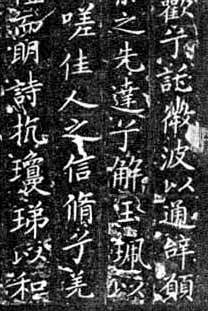Wang Xianzhi (344-386) Among the four major families of Wang, Xie, Xi, and Yu in the Eastern Jin Dynasty, the most prominent is the Wang family, and the most outstanding calligraphy achievements deservedly belong to the Wang family. clan. The Wang family has the most calligraphers. In this calligraphy family, there are fathers and sons competing for victory, brothers competing, husbands and wives competing, in-laws learning from each other, and passing on each other. This is not only extremely dazzling in the history of calligraphy, but also unique in the history of world art. In particular, there appeared the sage Wang Xizhi and his seventh son Wang Xianzhi. The father and son were collectively called the "Two Kings" by the world. This is the pride of the Wang family, and this is also the pride of Eastern Jin calligraphy.
clan. The Wang family has the most calligraphers. In this calligraphy family, there are fathers and sons competing for victory, brothers competing, husbands and wives competing, in-laws learning from each other, and passing on each other. This is not only extremely dazzling in the history of calligraphy, but also unique in the history of world art. In particular, there appeared the sage Wang Xizhi and his seventh son Wang Xianzhi. The father and son were collectively called the "Two Kings" by the world. This is the pride of the Wang family, and this is also the pride of Eastern Jin calligraphy.
Wang Xianzhi, also known as Zijing, also known as Guannu, was known as "Wang Daling" in the world. His calligraphy is in regular script, running script, cursive script, and official script. Xianzhi learned from his father as a child, and he has shown superhuman talents since he was a child. He is extremely talented and aggressive. Xianzhi is not restricted by his father. Unfortunately, God was jealous of his talent, and he died prematurely at the age of forty-two.
Wang Xianzhi's small regular script is represented by "Thirteen Lines of Luo Shen Fu" (pictured on the right), which is extended with a pen, and the structure is well-proportioned and neat, like a lady, with a charming and graceful posture.
His most famous running script is "Yatou Wan Tie". "Yatou Wan Tie" is a cursive calligraphy work by Wang Xianzhi. In the second line, the text says: "Yatouwan, so it is not good. I will gather it tomorrow and see you." There are fifteen words in total, which is a note written by Wang Xianzhi to his friends. The original is now in the Shanghai Museum. The whole post is written in dry and moist ink. Jiang Kui's "Xu Shu Pu·Using Ink" said: "When writing regular script, the ink should be dry, but not too dry. When writing cursive, dryness and moistness are mixed, and moistness is used to obtain beauty, and dryness is used to obtain danger." "Yatou Wan Tie" two chapters Layer meaning, dip in ink twice, one sentence at a time, the ink color will change from moist to dry, from thick to light, and the ink color will be clear. This shows the rhythmic ups and downs and natural changes in the charm of the whole post. The cursive style of "Manuscripts" is Wang Xianzhi's original calligraphy style, and "Yatou Wantie" is his representative work of cursive writing.
Wang Xianzhi's creation of "cursive script" was one of his major contributions, and his creation of cursive "one-stroke script" was another major contribution. He advanced Zhang Zhi's chapter cursive and his father Wang Xizhi's modern cursive. The famous cursive calligraphy work "Mid-Autumn Tie" is his representative work of "one-stroke calligraphy". The strokes are continuous, like a surging river, flowing thousands of miles, showing a refreshing atmosphere of majestic and heroic hair. The world thinks highly of it and is listed as a palace in the Qing Dynasty. "Three Hopes" No. 2.
Xi Xian and his son each had their own merits in calligraphy. Xi was distinguished by his true calligraphy, while Xian was distinguished by his cursive calligraphy. There was a period in the Tang Dynasty when Xi was promoted and Xian was promoted. In fact, when evaluating calligraphy, one cannot use one style of calligraphy to determine which one is inferior and which one is superior. Wang Xianzhi can stand out under the shadow of his father. This alone can illustrate Wang Xianzhi's extraordinary talent.
Wang Xian's brother Wang Huizhi, also known as Ziyou, was a minister of Huangmen. He was an unruly and unruly character, good at truthfulness and cursive writing. "Xuanhe Shupu" commented that he "followed the family law in Xixian", and his handed down works include " New Moon Post" etc.
In the Southern Dynasties, between Song, Qi, Liang and Chen, many people respected Wang Xianzhi's calligraphy. The great calligraphers Wang Sengqian (425-485), Wang Zhi and his son, who are descendants of the Wang family, are particularly notable. The Liaoning Museum has copies of the father and son's copies, which are the eighth "Wang Yan Tie" and the tenth "One Day Without Application" in the "Long Live Tongtian Tie".








